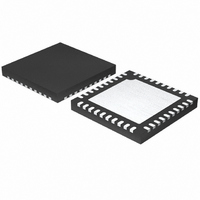MAX1544ETL+ Maxim Integrated Products, MAX1544ETL+ Datasheet - Page 26

MAX1544ETL+
Manufacturer Part Number
MAX1544ETL+
Description
IC QUICK-PWM DUAL-PHASE 40-TQFN
Manufacturer
Maxim Integrated Products
Series
Quick-PWM™r
Datasheet
1.MAX1544ETLT.pdf
(42 pages)
Specifications of MAX1544ETL+
Applications
Controller, AMD Hammer
Voltage - Input
2 ~ 28 V
Number Of Outputs
1
Voltage - Output
0.68 ~ 1.55 V
Operating Temperature
-40°C ~ 100°C
Mounting Type
Surface Mount
Package / Case
40-TQFN Exposed Pad
Output Voltage
0.675 V to 1.55 V
Output Current
40 A
Input Voltage
4 V to 28 V
Mounting Style
SMD/SMT
Maximum Operating Temperature
+ 100 C
Minimum Operating Temperature
- 40 C
Lead Free Status / RoHS Status
Lead free / RoHS Compliant
Dual-Phase, Quick-PWM Controller for
AMD Hammer CPU Core Power Supplies
The one-shot for the secondary phase varies the on-time
in response to the input voltage and the difference
between the main and secondary inductor currents.
Two identical transconductance amplifiers integrate the
difference between the master and slave current-sense
signals. The summed output is internally connected to
CCI, allowing adjustment of the integration time constant
with a compensation network connected between CCI
and FB.
The resulting compensation current and voltage are
determined by the following equations:
where Z
secondary on-time one-shot uses this integrated signal
(V
When the main and secondary current-sense signals
(V
unbalanced, the transconductance amplifiers adjust the
secondary on-time, which increases or decreases the
secondary inductor current until the current-sense
signals are properly balanced:
This algorithm results in a nearly constant switching
frequency and balanced inductor currents, despite the
lack of a fixed-frequency clock generator. The benefits of
a constant switching frequency are twofold: first, the
frequency can be selected to avoid noise-sensitive
regions such as the 455kHz IF band; second, the induc-
tor ripple-current operating point remains relatively con-
stant, resulting in easy design methodology and
predictable output-voltage ripple. The on-time one-shots
have good accuracy at the operating points specified in
the Electrical Characteristics. On-times at operating
points far removed from the conditions specified in the
Electrical Characteristics can vary over a wider range. For
example, the 300kHz setting typically runs about 3%
slower with inputs much greater than 12V due to the very
short on-times required.
On-times translate only roughly to switching frequencies.
The on-times guaranteed in the Electrical Characteristics
are influenced by switching delays in the external high-
side MOSFET. Resistive losses, including the inductor,
26
t
CCI
CM
ON ND
I
CCI
______________________________________________________________________________________
) to set the secondary high-side MOSFETs on-time.
(
= V
2
CCI
CMP
=
)
=
=
=
G
is the impedance at the CCI output. The
(
M
K
K
Main on time
Balance Correction
- V
(
V
V
CMN
V
V
CCI
CMP
FB
CCI
−
and V
=
+
V
-
V
+
IN
0 075
V
V
IN
0 075
.
FB
CMN
.
)
CS
+
+
V
)
I
V
CCI CCI
-
+
= V
(
G
Secondary Current
)
M
Z
CSP
K
(
V
I
CSP
CCI CCI
- V
V
Z
IN
CSM
-
V
CSN
) become
)
both MOSFETs, output capacitor ESR, and PC board
copper losses in the output and ground tend to raise the
switching frequency at higher output currents. Also, the
dead-time effect increases the effective on-time, reduc-
ing the switching frequency. It occurs only during forced-
PWM operation and dynamic output voltage transitions
when the inductor current reverses at light or negative
load currents. With reversed inductor current, the induc-
tor’s EMF causes LX to go high earlier than normal,
extending the on-time by a period equal to the DH-rising
dead time.
For loads above the critical conduction point, where the
dead-time effect is no longer a factor, the actual
switching frequency (per phase) is:
where V
the inductor discharge path, including synchronous recti-
fier, inductor, and PC board resistances; V
sum of the parasitic voltage drops in the inductor charge
path, including high-side switch, inductor, and PC board
resistances; and t
Without active current-balance circuitry, the current
matching between phases depends on the MOSFET’s
on-resistance (R
matching, and inductance matching. For example, vari-
ation in the low-side MOSFET on-resistance (ignoring
thermal effects) results in a current mismatch that is
proportional to the on-resistance difference:
However, mismatches between on-times, off-times, and
inductor values increase the worst-case current imbal-
ance, making it impossible to passively guarantee
accurate current balancing.
Table 6. Approximate K-Factor Errors
V
Float
REF
GND
CONNECTION
CC
TON
DROP1
I
MAIN
f
SW
-
is the sum of the parasitic voltage drops in
I
2
=
FREQUENCY
DS(ON)
ND
ON
SETTING
t
ON
(kHz)
=
100
200
300
550
is the on-time as determined above.
(
I
MAIN
V
), thermal ballasting, on-/off-time
(
IN
V
OUT
+
V
DROP
1
+
K-FACTOR
-
V
DROP
R
R
(µs)
1
3.3
1.8
Current Balance
MAIN
10
5
2
-
ND
V
1
DROP
)
2
DROP2
)
K-FACTOR
ERROR
±12.5
MAX
±10
±10
±10
(%)
is the











